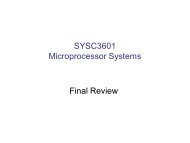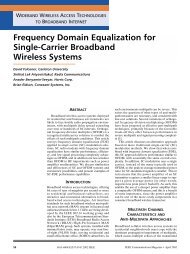Image Reconstruction for 3D Lung Imaging - Department of Systems ...
Image Reconstruction for 3D Lung Imaging - Department of Systems ...
Image Reconstruction for 3D Lung Imaging - Department of Systems ...
You also want an ePaper? Increase the reach of your titles
YUMPU automatically turns print PDFs into web optimized ePapers that Google loves.
where H is the Jacobian or sensitivity matrix and n is the measurement system noise,<br />
assumed to be uncorrelated additive white Gaussian (AWGN).<br />
For piecewise constant conductivity models, each element i, j, <strong>of</strong> H is defined as Hij �<br />
=<br />
∂zi �<br />
and relates a small change in the ith difference measurement to a small change in<br />
� ∂xj σ0<br />
the conductivity <strong>of</strong> jth element with respect to a background conductivity vector, σ0. H<br />
is a function <strong>of</strong> the FEM, the current injection pattern, the measurement pattern, and the<br />
background conductivity. We use the adjacent current injection pattern and a homogenous<br />
background conductivity with σ0 = 1 <strong>for</strong> each <strong>of</strong> the elements. H is a matrix comprised <strong>of</strong><br />
E columns <strong>of</strong> length M where E is the number <strong>of</strong> elements in the finite element model and<br />
M is the number <strong>of</strong> measurements per frame. Thus the ith column represents the change<br />
in the M boundary measurements due to a change in the conductivity <strong>of</strong> the ith element.<br />
There are several ways to calculate the Jacobian; the EIDORS2D toolset [116] uses the<br />
method <strong>of</strong> [114][127] (which is referred to as the Standard Method) whereas the EIDORS<strong>3D</strong><br />
toolset [93] uses a more efficient method involving the dot products <strong>of</strong> the interior electric<br />
fields.<br />
5.2.3 <strong>Image</strong> <strong>Reconstruction</strong><br />
In order to overcome the ill-conditioning <strong>of</strong> H we solve 5.5 using the following regularized<br />
inverse originally described in [4]<br />
ˆx = (H T WH + λ 2 R) −1 H T Wz = Bz (5.6)<br />
where ˆx is an estimate <strong>of</strong> the true change in conductivity, R is a regularization matrix, λ<br />
is a scalar hyper parameter that controls the amount <strong>of</strong> regularization, and W models the<br />
system noise covariance. We calculate λ using the BestRes algorithm described in chapter<br />
4. Noise is modeled as uncorrelated with conductivity changes and among measurement<br />
channels; thus, W is a diagonal matrix with Wi,i = 1/σ 2 i where σ2 i is the noise variance<br />
<strong>for</strong> measurement i. W can also be modified to account <strong>for</strong> variable gain settings on each<br />
tomograph channel. With R = I (labelled RTik) equation 5.6 is the 0 th order Tikhonov<br />
algorithm. With R = diag(H T H) (labelled Rdiag) equation 5.6 is the regularization matrix<br />
used in the NOSER algorithm [35]. In [4] R is a model <strong>of</strong> the inverse a priori image<br />
covariance. EIT has the potential <strong>for</strong> only a relatively few independent measurements. As<br />
a direct consequence there will be limited high spatial frequency content and there<strong>for</strong>e low<br />
spatial resolution, associated with any reconstructed image. This implies that the elements<br />
with a separation less than the minimum recoverable spatial period (EIT resolution) are<br />
highly correlated. Consequently Adler and Guardo [4] model R as a spatially invariant<br />
Gaussian high pass filter (labelled RHPF) with a cut-<strong>of</strong>f frequency selected so the spatial<br />
period is a given fraction <strong>of</strong> the medium diameter. In two dimensions a Gaussian high pass<br />
filter <strong>of</strong> spatial frequency ω0 has the <strong>for</strong>m<br />
F(u,v) = 1 − e −ω0(u 2 +v 2 )<br />
In the spatial domain the convolution kernel is<br />
(5.7)<br />
f(x,y) = δ(x,y) − π<br />
ω2 e<br />
0<br />
−(π2 /ω2 0)(x2 +y2 ) (5.8)<br />
where δ(x,y) is the Dirac delta function. The filtering matrix F multiplies an image vector<br />
x to give a filtered image Fx. Fij is calculated by centering the high pass filter in element<br />
65





